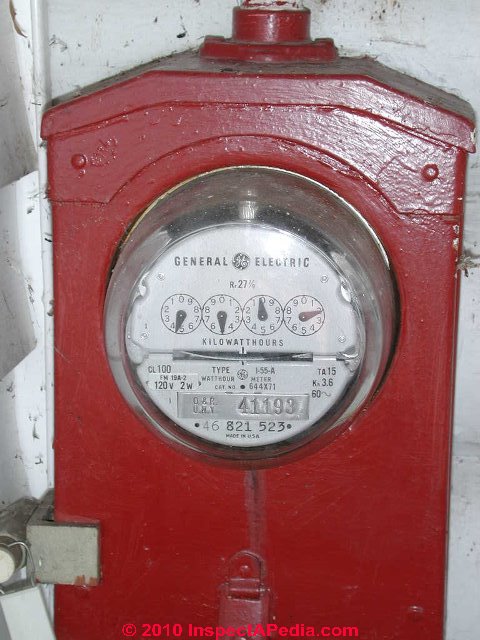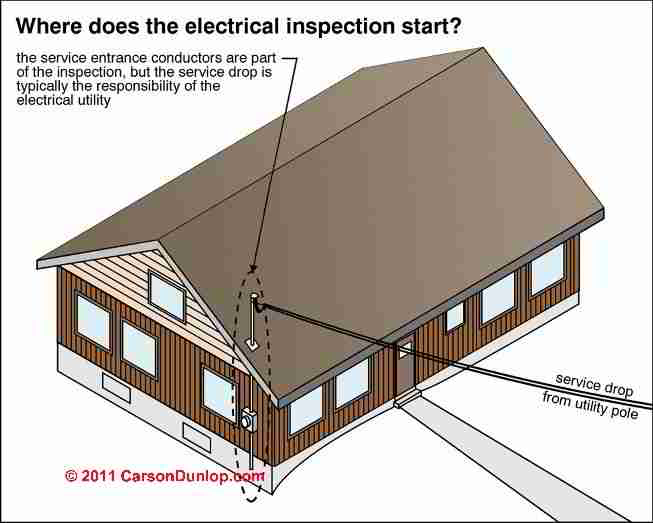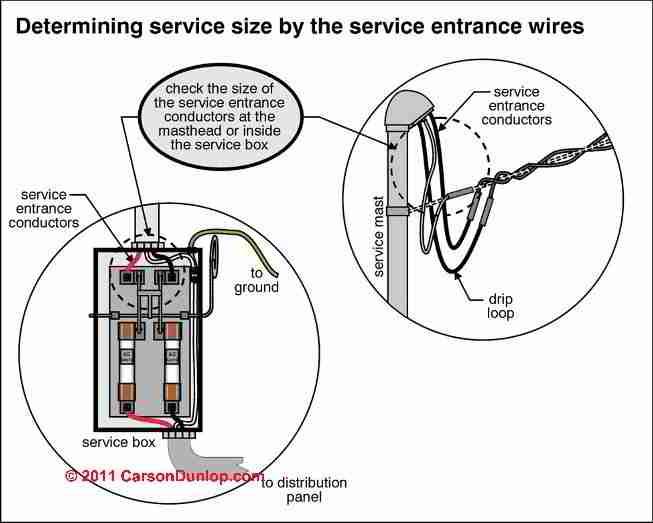 Find the Electrical Service Ampacity & Size or Voltage by Visual Inspection
Find the Electrical Service Ampacity & Size or Voltage by Visual Inspection
Looking at the number of wires gives Service Voltage
Looking at wire size (and other compnents) gives Service Amperage
- POST a QUESTION or COMMENT about how to determine the size or capacity of an electrical system (amps and volts) by visual inspection
How to determine the electrical service capacity at a residential property by visual inspection alone: introduction.
By looking at just the number and size of wires we can find the electrical service voltage and amperage delivered to a building.
While there may be other limiting factors yet to be found (such as panel or main breaker size), just by eye, no equipment, no touching, no testing, we can find this basic information.
Page top photo: an obsolete GE electric meter.
InspectAPedia tolerates no conflicts of interest. We have no relationship with advertisers, products, or services discussed at this website.
- Daniel Friedman, Publisher/Editor/Author - See WHO ARE WE?
Determining the Electrical Service Ampacity and Voltage at a building by visual inspection - Introduction
 Can I determine the service amperage at a building simply by looking at the service entry wire or panel?
Can I determine the service amperage at a building simply by looking at the service entry wire or panel?
When a homeowner or renter asks "how much" electrical service is provided, they want to know the buildings's service ampacity and voltage.
Here we explain that by simply looking at a few components of the system without touching them, we can make a reasonably accurate answer to the question.
In the US and Canada service voltages are commonly (nominally, that is, not exactly) 240 volts at the electrical panel, a system which supports both 120V and 240V circuits in the building.
The electrical masthead sketch at above-left, courtesy of Carson Dunlop Associates, shows where this electrical inspection starts - outside at the electric masthead.
Is the Electrical Service 120Volts or 240Volts?
Typically, two individual 120V hot wires entering the building provide 120V for circuits connected from an individual entering wire and the neutral bus, and 240V is also available for circuits that are connected between the two incoming individual 120V circuits.
A 240V electrical service will show at least these three wires
- First 120VAC service wire
- Second 120VAC service wire
- Third a service neutral or ground wire. The incoming neutral wire is grounded at a utility pole and may also serve to support the incoming hot wires.
Older building electrical services, typically those installed before 1940, may support only 120V and as little as 30-amps.
We still find these services on small cabins and on a few old residences in the U.S., Canada, and Mexico and elsewhere.
A 120V electrical serives will show just two wires
- A 120VAC servcie wire
- A service neutral or ground wire
Sketches above and below are provided courtesy of Carson Dunlop Associates.
The sketch beleow shows outdoor detailed components of a 240V electrical service.
For normal residential use, excluding small vacation cottages, a 120V or 30A service would most likely be considered obsolete and has been since 1959 (Hansen).
[NOTE for home inspectors: 1992 ASHI Standards of Practice (and later) , 8.2.1. While ASHI and other building inspection standards are updated periodically, the basic requirements addressed in this article should not change.]
What is the Electrical Service Size or Ampacity Provided by the Service Entrance Conductors

It's not as difficult as one may think to get a reasonable handle on the electrical service capacity at a building without sophisticated analysis.
As Carson Dunlop Associates sketch (left) illustrates, the electrical capacity that is provided by the service entrance conductors is determined by checking the wire size where they wires are accessible.
Keep in mind that while the SEC wires are just one limiting factor in setting the ampacity and voltage available at a building, other electrical components (main breaker and panel size, for example) may set lower limits.
So you'll also want to see ELECTRICAL SERVICE AMPS LIMITING FACTOR
Also keep in mind that when looking at SEC wire sizes, we refer to the wiring from the masthead down to the electrical meter and the SEC wires between the electrical meter and the service disconnect or main circuit breaker or fuse. We do not usually inspect nor consider the diameter of the overhead or underground feeders coming to the building during a home inspection.
Watch out: inspecting and/or touching electrical components is inherently dangerous and there is risk of shock or death by electrocution.
Electrical inspections are inherently dangerous to the inspector and potentially dangerous to inspection clients and building occupants.
People conducting these procedures must first be familiar with safe electrical practices before attempting any inspection of electrical equipment. Such familiarity is essential to protect all parties concerned. Inspectors: proceed at your own risk.
See SAFETY for ELECTRICAL INSPECTORS at Residential Electric Panels.
We have divided the topic of determining the ampacity of electrical service at a building into the articles listed below at Continue Reading .
...
Continue reading at ELECTRICAL PANEL INTERIOR HAZARDS or select a topic from the closely-related articles below, or see the complete ARTICLE INDEX.
Or see
Recommended Articles
- AMPS VOLTS DETERMINATION - home
- AMPS, LIMITING FACTORS
- AMPS & SEC SIZES
- AMPS & VOLTS, DETERMINE VISUALLY
- AMPS MEASUREMENT AUTOMOTIVE DC
- AMPS MEASUREMENT METHODS
- AMPACITY, MAIN DISCONNECT
- DEFINITIONS AMPS VOLTS WATTS
- ELECTRIC METERS & METER BASES
- ELECTRIC MOTOR HORSEPOWER & CIRCUIT WIRE SIZE
- ELECTRICAL PANEL AMPACITY
- VOLTAGE at the SEC
- UNDERGROUND SERVICE LATERALS
- AMPS MEASUREMENT AUTOMOTIVE DC
- AMPS MEASUREMENT METHODS
- ELECTRICAL INSPECTOR SAFETY PROCEDURES important basic safety procedures, clothing, and equipment for home inspectors and electrical inspectors.
- ELECTRICAL SERVICE AMPS LIMITING FACTOR
- VOLTS / AMPS MEASUREMENT EQUIP
Suggested citation for this web page
VISUALLY DETERMINE AMPS & VOLTS at InspectApedia.com - online encyclopedia of building & environmental inspection, testing, diagnosis, repair, & problem prevention advice.
Or see this
INDEX to RELATED ARTICLES: ARTICLE INDEX to ELECTRICAL INSPECTION & TESTING
Or use the SEARCH BOX found below to Ask a Question or Search InspectApedia
Ask a Question or Search InspectApedia
Questions & answers or comments about how to determine the size or capacity of an electrical system (amps and volts) by visual inspection.
Try the search box just below, or if you prefer, post a question or comment in the Comments box below and we will respond promptly.
Search the InspectApedia website
Note: appearance of your Comment below may be delayed: if your comment contains an image, photograph, web link, or text that looks to the software as if it might be a web link, your posting will appear after it has been approved by a moderator. Apologies for the delay.
Only one image can be added per comment but you can post as many comments, and therefore images, as you like.
You will not receive a notification when a response to your question has been posted.
Please bookmark this page to make it easy for you to check back for our response.
IF above you see "Comment Form is loading comments..." then COMMENT BOX - countable.ca / bawkbox.com IS NOT WORKING.
In any case you are welcome to send an email directly to us at InspectApedia.com at editor@inspectApedia.com
We'll reply to you directly. Please help us help you by noting, in your email, the URL of the InspectApedia page where you wanted to comment.
Citations & References
In addition to any citations in the article above, a full list is available on request.
- The Original Authors: Alan Carson is an ASHI Member, national home inspection educator, author and building failures researcher in Toronto, Ontario. Daniel Friedman, an original author of this article and the editor and producer of InspectAPedia where this article now appears is an ASHI Member, first ASHI Technical Committee chairman, editor and publisher of the ASHI Technical Journal, licensed home inspector, educator, and building failures researcher in Poughkeepsie, NY. Robert Klewitz is a licensed professional engineer, a professional home inspector, an ASHI Member, and has served on the ASHI Technical Committee as well as in other ASHI activities. His practice is in Issaquah, WA.
- ASHI Technical Journal, Vol. 2. No. 1, January 1992, "Determining Service Ampacity," Dan Friedman and Alan Carson, and the
- ASHI Technical Journal, Vol. 3. No. 1, Spring, 1993, "Determining Service Ampacity - Another Consideration," Robert L. Klewitz, P.E., with subsequent updates and additions to the original text ongoing to 2/19/2006. Reprints of the originals and reprints of the Journal are available from ASHI, the American Society of Home Inspectors www.ashi.com.
- Mark Cramer Inspection Services Mark Cramer, Tampa Florida, Mr. Cramer is a past president of ASHI, the American Society of Home Inspectors and is a Florida home inspector and home inspection educator. Contact Mark Cramer at: 727-595-4211 mark@BestTampaInspector.com 11/06
- Douglas Hansen, Robert Stead. Mark Cramer. Photographs: Daniel Friedman.
- N. Srinivasan, MSEE, is a senior member of IEEE with 30 years experience in the electrical industry. Mr. Srinivasan is in Vienna VA.
- Louis P. Babin generously contributed technical editing about the effects of doubling ampacity in an electrical circuit (September 2007)
- In addition to citations & references found in this article, see the research citations given at the end of the related articles found at our suggested
CONTINUE READING or RECOMMENDED ARTICLES.
- Carson, Dunlop & Associates Ltd., 120 Carlton Street Suite 407, Toronto ON M5A 4K2. Tel: (416) 964-9415 1-800-268-7070 Email: info@carsondunlop.com. Alan Carson is a past president of ASHI, the American Society of Home Inspectors.
Thanks to Alan Carson and Bob Dunlop, for permission for InspectAPedia to use text excerpts from The HOME REFERENCE BOOK - the Encyclopedia of Homes and to use illustrations from The ILLUSTRATED HOME .
Carson Dunlop Associates provides extensive home inspection education and report writing material. In gratitude we provide links to tsome Carson Dunlop Associates products and services.


